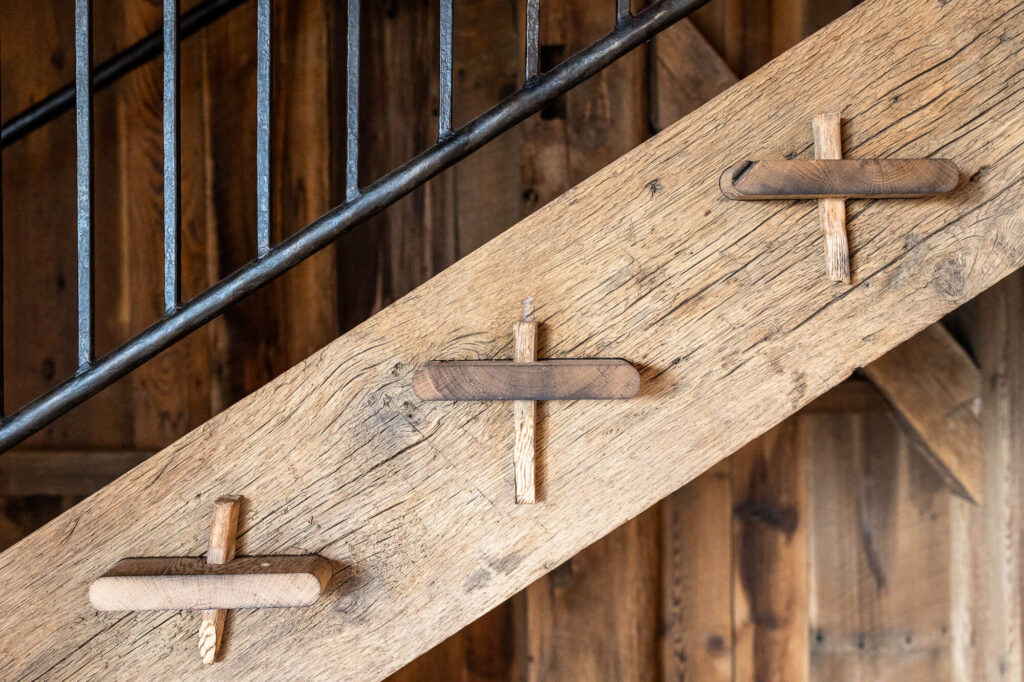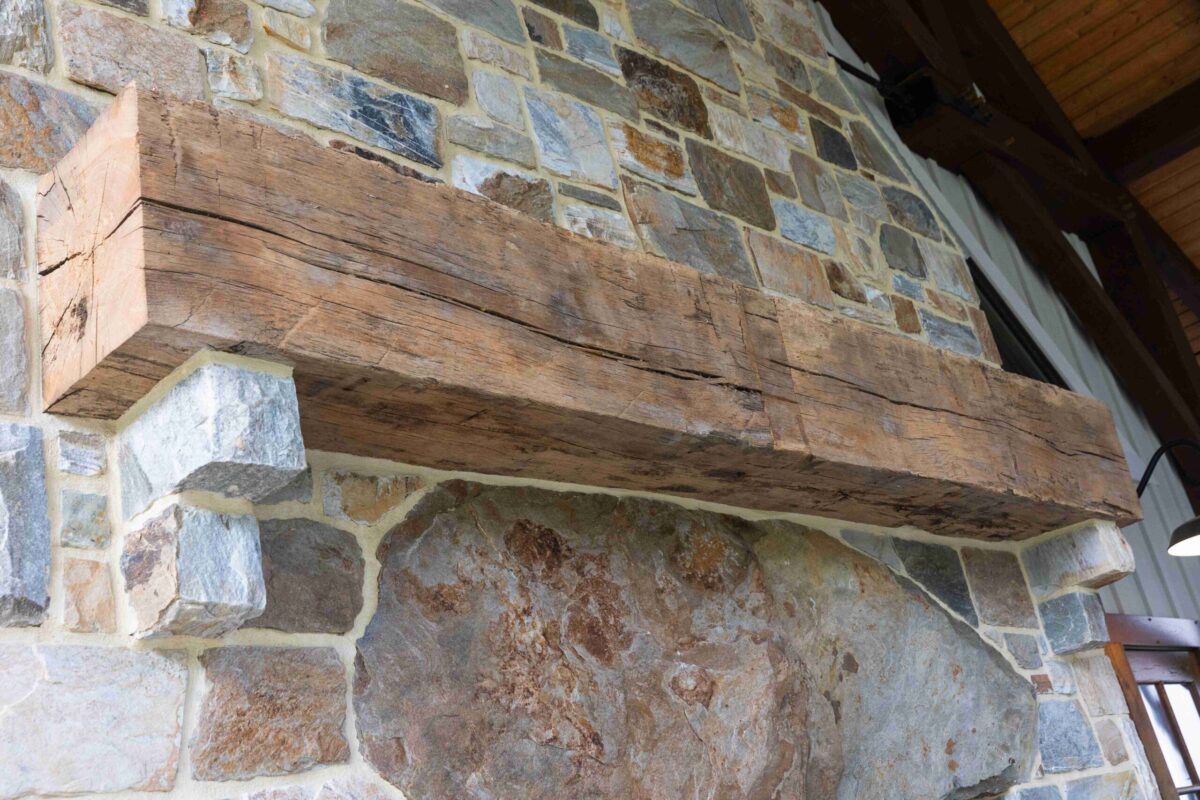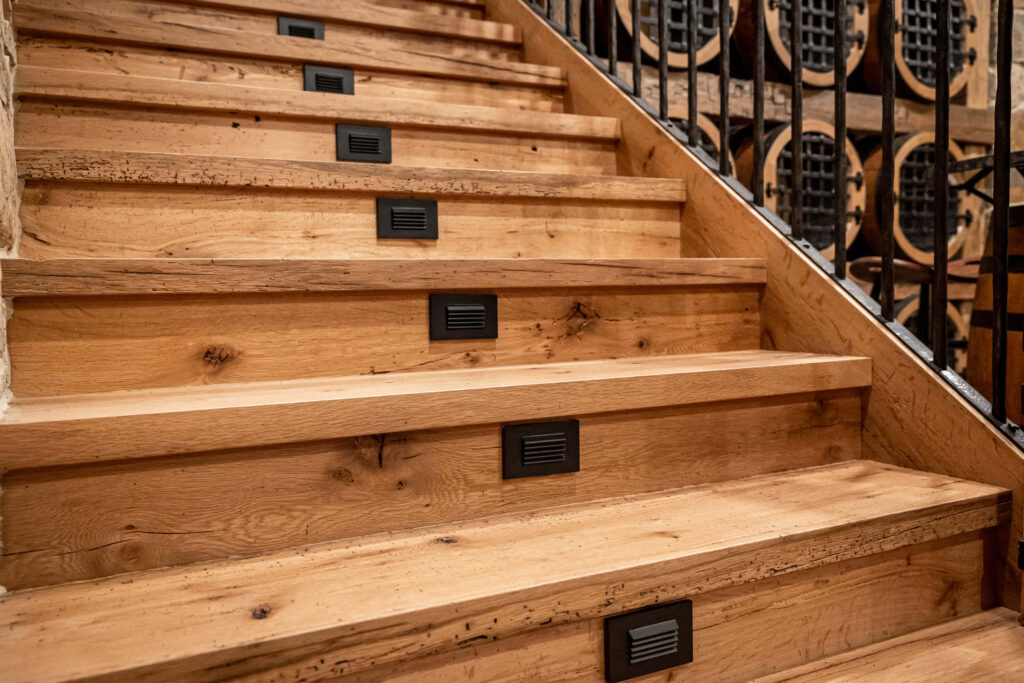Have you ever gotten a reclaimed wood mantel or beam and noticed a long crack running through it? Oh no, you may be thinking, this wood is falling apart. Your trusted team of vintage wood experts are here to tell you that’s not true! Today, we’ll cover everything you need to know about the visual characteristics of wood like splits and checks.
What Are Checks And Splits In Wood?
Those long splits (or “cracks”) that form parallel to the grain are called wood checking. But don’t worry! It’s a completely natural process that occurs as wood dries and the fibers separate.
Wood is hygroscopic, meaning it absorbs moisture from its surroundings when it’s humid and loses water when it’s dry. When a tree is cut, that moisture begins to evaporate, and as wood dries, it shrinks.
However, it doesn’t do this evenly across the board. Wood typically shrinks twice as much tangentially (parallel to the growth rings) as it does radially (perpendicular to the growth rings). In addition, the outside dries much quicker than the inside. This uneven shrinkage causes checks.
You can speed the drying process along with a kiln. We have a full-size vacuum kiln that we use to get your reclaimed timber to the correct moisture content while debugging it at the same time.
Once your reclaimed wood is completely dried out in the kiln, it has no more moisture to lose. This means it won’t continue to dry out in your home. By the time it’s installed, it has already developed checks and will not continue to split.

Misconceptions About Wood Checking
A lot of people misunderstand wood checking. They see a “crack” and think the lumber is falling apart. They notice a split and worry about the structural integrity of the wood. If you’ve had these thoughts, you’re not alone! Here are some of the common misconceptions about checks and splits in wood:
1. They Are A Sign Of Low-Quality
While splits may seem like a bad thing, they do not mean your wood is low-quality or falling apart. On the contrary, it is a sign that your lumber is dry, which is crucial. Splits and checks are a natural part of the reclaimed wood experience and should be celebrated.
2. My Wood Will Continue To Split
Another misconception people have about wood checking is that it will only get worse as time goes on. Like we mentioned above, your hand-hewn beams, mantels, and other wood will not continue to split as long as they are in a stable environment (such as your house). However, checks may shrink and grow in environments with changing humidity and weather like the outdoors.
3. My Reclaimed Pieces Are Weak
If you examine a piece of reclaimed wood, you will notice that the cracking doesn’t cut across the grain. This is how you know it doesn’t impact the strength or structural integrity of the wood. In fact, as wood dries, it becomes stronger.
Are Splits A Good Thing?
Checks, splits, and other characteristics of wood are tell-tale signs of reclaimed lumber and shouldn’t be seen as a flaw. Here are a few reasons why:
- They add character. The imperfections in wood add uniqueness and character that you can only get when you choose reclaimed. These marks tell a story and show that your wood has a history.
- They have a rustic feel. Reclaimed timber has a very specific look. When you fill your home with checked wood, it adds to that rustic element and gives off a natural beauty.
- They release pressure. These checks help your reclaimed wood release internal stress, which can actually prevent future warping.
So are splits and checks bad? Not at all! They add a special visual element to your wood without impacting the functionality or strength.
Other Characteristics Of Wood To Watch Out For
Imperfections in wood aren’t something to shy away from. Just like with checking, they add a touch of charm. Here are some other common characteristics of wood that you may notice in your reclaimed pieces.
Worm Holes
Worm holes are created when woodworms burrow into a soft or defective part of the wood. These insects are actually beetles, not worms, and the exit holes they leave behind are common in reclaimed lumber, a reminder of its past life.
Worm holes in wood vary in size and tend to be grouped together. But don’t worry about your pieces being infested. After treatment in the kiln, your reclaimed lumber is perfectly safe to enter your home.
Nail Holes
Another common characteristic of wood is nail holes. Whether your reclaimed lumber came from an old barn or other source, nail holes are very common. The size and amount can vary depending on the age of the wood, adding character.
Knots
Just like checks, knots are natural irregularities in wood that form where branches once grew out of trees. The dark rings offer a rustic, natural look to your reclaimed lumber and add an interesting grain pattern. Unfortunately, some knots can also weaken wood because they interrupt the grain, making them not ideal for load-bearing applications.
Mineral Deposits
Mineral deposits are formed when trees absorb minerals from the soil. They appear as black, gray, or green streaks that run parallel to the grain. These are most commonly seen in lighter woods like hickory or cherry.
Similar to mineral deposits are mineral stains. Rather than a clear streak, this stain appears blotchy throughout an entire piece and is most common in oak species.
Uneven Edges
Reclaimed lumber isn’t picture-perfect. That’s what we love about it! It has a clear past and sometimes that results in uneven edges. Our live edge wood products emphasize this for unique and textured designs.
Why Choose Reclaimed?
Out with the new, in with the old. When you choose reclaimed wood for your next project, you’re preserving history. The weathered look of the wood isn’t artificial; it comes with a story and you are continuing the legacy.
In addition, reclaimed timber from old-growth trees is stronger than newly-cut trees. Its sturdiness is not impacted by splits and checks, making it a great choice for home renovation projects.
Another reason to choose reclaimed wood is because it’s sustainable! When you pick salvaged lumber, you are not contributing to deforestation, and it reduces waste. Since no new products have to be manufactured, you’re also cutting carbon emissions.
Our reclaimed barn wood and custom, hand-forged ironworks are the building blocks you need to create statement pieces in your home. Every split, check, knot, and hole has a story. We can’t wait to see how you embrace the unique visual characteristics of wood.
Understanding reclaimed lumber is important for any project. Request a quote today and work with us to bring rustic charm and history into your home.


